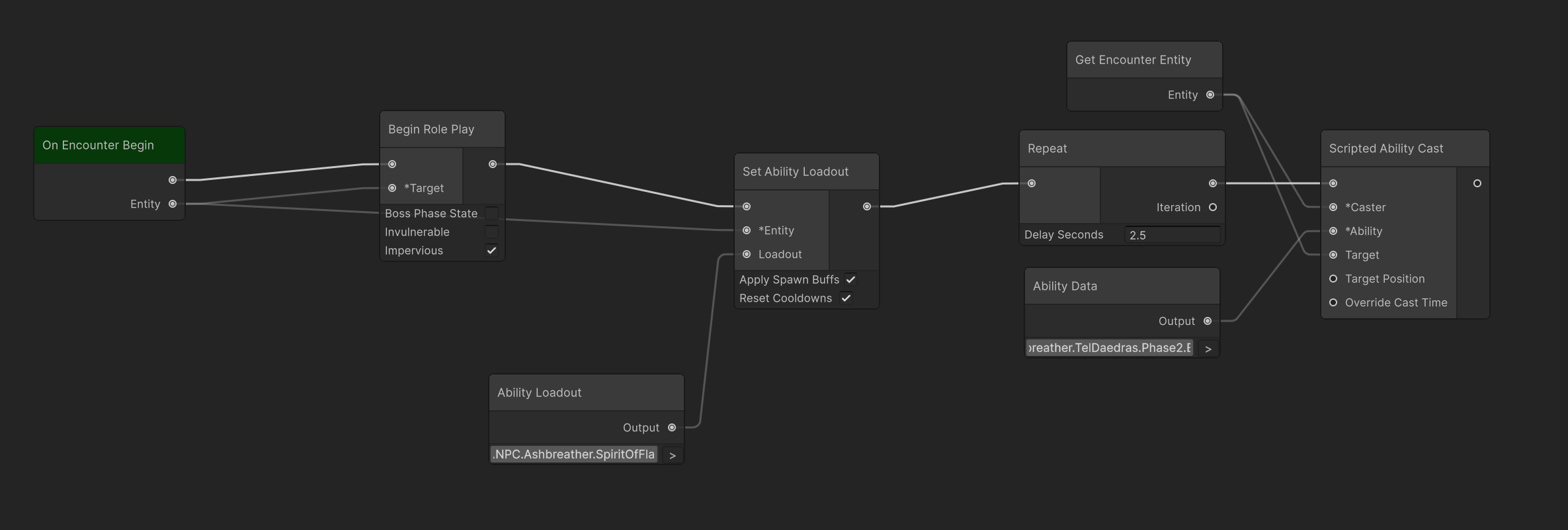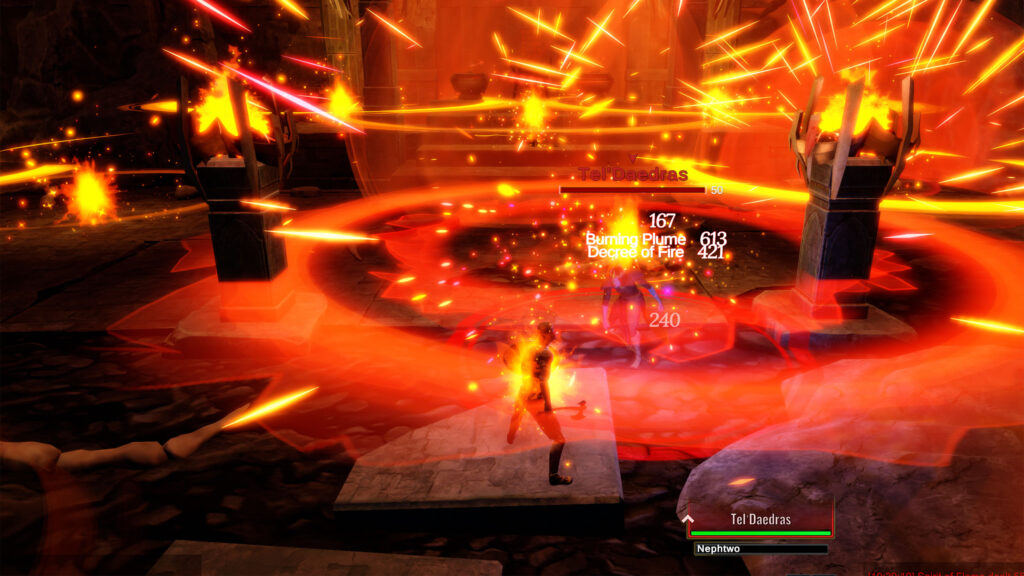By Pantheon Design Team
What goes into designing a major boss encounter?
One of the aspects of our game we’ve been starting to work on more over the past few months is our boss NPC encounters. While we want all of our content to be challenging, there’s just something special about getting to the end of the dungeon (or even just the side room) and having an epic, memorable fight. Ideally, we want each of our boss NPCs to challenge players in different ways, and to feel very distinct from each other. Making that happen isn’t always as simple as it sounds, however.
For today’s dev diary, we wanted to pull back the curtain a little and give you all some insight into the process we are using to design these boss encounters.
Step 1: Treat it like a Story
The most memorable RPG fights tell a story. They have a beginning, a middle, and an end. If you’re going into a fight for the first time, there should be things that surprise you, twists that you perhaps didn’t see coming. Obviously, in a social game like ours, you might already have heard from other players what to expect, but we want the events that happen during the fight to be exciting.
So, when we envision these boss fights, we start by thinking about the storyline of the fight. For example:
This may seem a little silly, but it helps us establish the flow of the fight and the types of things we want to have happen during the encounter. We always try to start with something like this, because it makes the rest of the process much easier.
Another aspect that we try to consider when building out the story of the fights is how we want players to be challenged. For example, should the fight be an endurance fight where players must outlast their opponents? Do we want to keep a lot of damage focused on the tank or spread it out among the group? Should it require tactical repositioning and moving the boss around to avoid damage? Should it feature environmental hazards that players need to work around? Having a good picture of the flow and feel of the fight helps us as we begin to sketch out the encounter.
Step 2: Theming
Once we have the general flow worked out, the next step is to establish the themes we want to leverage in the fight. Maybe our boss is a powerful necromancer, or perhaps he’s a brutish warlord. We spend some time brainstorming exactly who our boss NPC is and what kinds of things they might do in a fight. For example:
• Is the boss a spellcaster? A melee fighter? Both?
• Does the boss fight alone or do they have minions/helpers?
• What sorts of attacks does the boss use? Do they do big sweeping strikes with a weapon? Bathe the area in fire? Call down lightning from the heavens?
• Is there anything special about the location of the fight? Spikes in the floor? A door that locks behind the players?
Step 3: Special Moves
No MMORPG villain is complete without a special signature move or two. So, after we work out the themes of the fight, we try to brainstorm a few of these things that they can do. This is an important step since sometimes these attacks might involve some custom animations that we need to create.
We often have more ideas than we can really implement at this stage – sometimes there are technical limitations that prevent us from using an idea, and sometimes our initial ideas are really cool, but they don’t really fit well with the storyline of the fight.
Step 4: Putting it all together

Big boss encounters can have dozens of script entries like this one.
Once we’ve got the flow of the fight, the theme, and the special moves figured out, it’s time to start building everything. This is the part that can take the longest. Not only do we have to create the abilities the boss will use (and potentially animations and visual effects for those), but we also have to set up targeting conditions and cooldowns for those abilities. For example, do we want the boss to use it on the person with the highest threat, attack the healer with it, or to target someone randomly in the group they are fighting? Do we want them to use it every 15 seconds during the fight, or only at certain times? Do we want them to use the ability as soon as the fight starts or wait a bit before they start using it?
In addition to the big, flashy moves, we also need to make sure that the boss has several more mundane things that it can do. If we only had the big moves, fights would feel very odd, since the boss wouldn’t be doing anything at all in between those big moves. Most of our bosses will have several smaller abilities that they can do in between the big things, which helps make the fight feel more dynamic and interesting.
We typically go through a few iterations before we finally land on an overall set of abilities that we feel works well together. Depending on the fight, sometimes this process can take a few weeks just to get to this point. During this time, we’re also usually finalizing the loot for the boss NPC as well (since we have a decent understanding of its intended rarity and difficulty).
Step 5: Testing and Tuning

Hey Sav, can you come over here for a second and help test something? We promise it won’t hurt…
After we have all the abilities set up and everything put together on our boss NPC, it’s time to do some testing and tuning. For this, we like to use our unsuspecting coworkers and our focus testers. We have them join our internal test server, group up, and then we unleash our new boss upon them and watch to see what happens.
Sometimes, we get things right the first time, and our boss proves to be a challenging and fun encounter with very little tuning needed. More often though, we start finding situations we didn’t anticipate that we need to address. For example, in a recent test we had a problem with a boss that would summon its minions, but the minions were too far away to notice the players and attack them. We’ve had situations where the boss’s big attack was just a little too big and resulted in every other NPC nearby swarming in to attack the boss. And of course, sometimes we just find bugs. In some recent testing we had a boss get stuck in a loop where it would keep performing the same action repeatedly.
When we are tuning the boss, for most fights we try to aim for a level where the fight will be challenging for an “average” group of players. This can be somewhat tough to gauge, but our main goal is to make sure that the fight is memorable and fun for people who attempt it, and not something that is easy or forgettable. After all, these are bosses that we are talking about. For what we term “major bosses”, we will sometimes tune them a little higher specifically so that they will still pose challenge our most skillful and organized players. However, we have an overall goal that all our content should be accessible to groups who put in the time and effort to learn the encounters, so we generally try to keep a baseline difficulty that is challenging but doable for most groups.
From start to finish, this process can take weeks or even months alongside the other work we are doing to build out new content, but it is very important to us that we are creating compelling content for our players to experience, and that includes having exciting boss fights.
